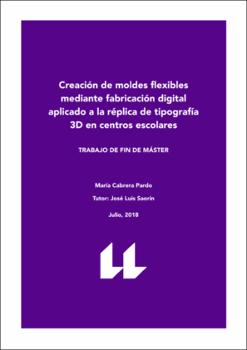Creación de moldes flexibles mediante fabricación digital aplicado a la réplica de tipografías 3D en centros escolares.
Author
Cabrera Pardo, MaríaDate
2021Abstract
El uso de la tipografía data de siglos
antes de Cristo, donde la caligrafía
era el medio de comunicación. En la
actualidad, se ha reinventado para dar
paso a la tipografía digital. La asignatura
de Tipografía se imparte en las
enseñanzas de Artes Plásticas y Diseño,
especialmente en los ciclos formativos
y en las enseñanzas superiores. Hoy
en día, su realización pasa del método
de dibujo tradicional a la pantalla,
normalmente es una transición de 2D
en papel a 2D digital. Por lo general,
no se trabaja la creación de tipografías
en tres dimensiones. En este artículo,
se presenta una posibilidad adicional
que consiste en el paso de tipografía
2D a las tres dimensiones, tanto digital
como tangible, con el objetivo de poder
realizarlo en los estudios anteriormente
nombrados. Para ello, se utiliza la
impresión de moldes tridimensionales
mediante tecnologías 3D de bajo coste,
lo que nos permite, no solamente dar
volumen a una tipografía que será
tangible, sino que además se le podrá
incluir otro tipo de texturas. Con este
proceso, el alumnado investigará y dará
otro enfoque al estudio de la tipografía,
incluyendo la impresión digital que
empieza a ser cada vez más latente en
el sistema educativo. Las tecnologías
que se han usado para llevarlo a cabo
han sido elegidas con el fin de que
sean accesibles para el profesorado
y el alumnado. Esta actividad se ha
sido puesta en práctica por alumnos
y alumnas de Tipografía, en las
Enseñanzas Superiores de Diseño
Gráfico 2017-2018 Abstract.
The use of typography dates from
centuries before Christ, where
calligraphy was one of the ways of
communication. Currently, it has been
reinvented to give a step to digital
typography. The subject of typography
is being taught in plastic arts and
design classes, especially in Vocational
Training and University. Nowadays,
its goes from the traditional drawing
method to the screen, it is usually a
transition from handwriting 2D to
digital 2D. The creation of typography
in three-dimensions is not normally
used. That is why in this article an
additional possibility is presented. It
consists in turning 2D typography into
the three-dimensions, both digital and
tangible in order to apply this technique
in the previously mentioned studies.
Therefore, three-dimensional moulds
are used with the help of low-cost 3D
technologies, which allows us not only
to give volume to a typography that
will be tangible, but also to be able
to include other types of textures.
In this process, the students will
investigate and give another approach
to the study of typography, including
the digital printing that begins to be
important in the educational system.
The technologies that have been used to
carry it out have been chosen in order to
be accessible to teachers and students.
This activity has been put into practice
by students of Typography subject in
the Higher Graphic Design courses of
the 2017/2018 academic year.





